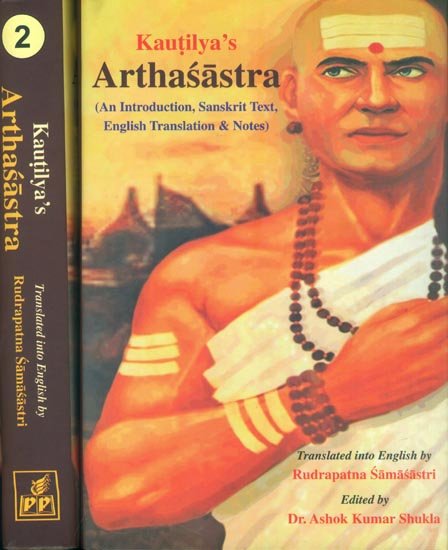Kautilya Arthashastra
by R. Shamasastry | 1956 | 174,809 words | ISBN-13: 9788171106417
The English translation of Arthashastra, which ascribes itself to the famous Brahman Kautilya (also named Vishnugupta and Chanakya) and dates from the period 321-296 B.C. The topics of the text include internal and foreign affairs, civil, military, commercial, fiscal, judicial, tables of weights, measures of length and divisions of time. Original ...
Chapter 4 - Remedies Against the Injuries of One’s Own Army
[Sanskrit text for this chapter is available]
With regard to remedies against poisons and poisonous compounds applied by an enemy against one’s own army or people: When the things that are meant for the king’s use, inclusive of the limbs of women, as well as the things of the army, are washed in the tepid water prepared from the decoction of śleṣmātaka (sebesten or cordia myk), kapi (emblica officinalis), madanti (?), danta (ivory), śaṭha (citron tree), gojigī (gojihva?—elephantophus scaber), viṣa (aconitum ferox), pāṭali (bignonia suaveolens), bala (lida cardifolia et rombifolia), syonāga (bignonia indica), punarnava (?), śveta (andropogon aciculatum), and tagara (tabernoe-montana coronaria), mixed with candana (sandal) and the blood of sālāvṛkī (jackal), it removes the bad effects of poison.
The mixture prepared from the biles of pṛṣata (red spotted deer), nakula (mungoose), nīlakaṇṭha (peacock), and godhā (alligator), with charcoal powder (maṣīrāji), combined with the sprouts (agra) of sinduvāra (vitex trifolia), tagara (tabernoe-montana coronaria), varuṇa (teriandium indicum), tandulīyaka (amaranthus polygamus), and śataparva (convolvulus repens), together with piṇḍītaka (vanqueria spinosa), removes the effects of the mixture of madana.
Among the decoctions of the roots of sṛgāla vrintā [sṛgālavṛntā?] (bignonia indica), madana, sinduvāra (vitex trifolia), tagara (tabernce-montana coronaria), varana (Grataeva Roxburghii) and vallī (a creeper?), any one or all mixed with milk removes, when drunk, the effects of the mixture of madana.
The stinking oil extracted from kaiḍarya (vangueria spinosa) removes madness.
The mixture prepared from priyaṅgu (panic seed) and naktamāla (galedupa arborea) removes, when applied through the nose, leprosy
The mixture prepared from kuṣṭha (costus) and lodhra (symplocus) removes consumption.
The mixture prepared from kaṭuphala (glelina arborea), dravanti (anthericum tuberosum), and vilaṅga (a kind of seed) removes, when applied through the nose, headache and other diseases of the head.
The application of the mixture prepared from priyaṅgu (panic seed), mañjiṣṭha (rubia manjit), tagara (tabernce-montana coronaria), lākṣārasa (the juice or essence of lac), madhuka (?), harridrā [haridrā?] (turmeric), and kṣaudra (honey), to persons who have fallen senseless by being beaten by a rope, by falling into water, or by eating poison, or by being whipped, or by falling, resuscitates them.
The proportion of a dose is as much as an akṣa (?) to men; twice as much to cows and horses; and four times as much to elephants and camels.
A round ball (maṇi) prepared from the above mixture and containing gold (rukma) in its centre, removes the effects due to any kind of poison.
A round ball (maṇi) prepared from the wood of aśvettha [aśvattha?] (holy fig tree) growing wound round with the plants such as jīvantī (a medicinal plant), śveta (andropogan aciculatum), the flower of muṣkaka (a species of tree), and vandāka (epidendrum tesseloides), removes the effects due to any kind of poison.[1]
* The sound of trumpets painted with the above mixture destroys poison; whoever looks at a flag or banner besmeared with the above mixture will get rid of poison.
* Having applied these remedies to secure the safety of himself and his army, a king should make use of poisonous smokes and other mixtures to vitiate war against his enemy
[Thus ends Chapter IV, “Remedies Against the Injuries of One’s Own Army,” in Book XIV, “Secret Means” of the Arthaśāstra of Kauṭilya. End of the hundred and forty-ninth chapter from the beginning.
With this ends the Fourteenth Book, “Secret Means” of the Arthaśāstra of Kauṭilya.]
Footnotes and references:
[1]:
There seems to be some error in this passage, and its meaning is not quite certain; see also Chapter XX, Book I.
